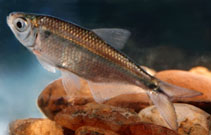| Family: |
Characidae (Characins; tetras), subfamily: Stethaprioninae |
| Max. size: |
6.11 cm SL (male/unsexed) |
| Environment: |
pelagic; freshwater; depth range - 2 m |
| Distribution: |
South America: Argentina. |
| Diagnosis: |
Diagnosis: Distinct from its congeners in having a round or trapezoidal black humeral spot, dorsal to the lateral line; a branch of the infraorbital sensory canal directed ventrally, continued as a series of pores totally or partially traversing the third infraorbital; body relatively slender (31.8-37.4% SL); eye large (41.1-45.8% HL); snout short (15.5-20.9% HL); caudal peduncle relatively slender (10.3-12% SL); one pentacuspid maxillary tooth; pored lateral line scales 38-42; and anal fin rays v-vi, 23-29. The males have breeding tubercles on the head and scales, and bony hooks on all fins (Ref. 57546). |
| Biology: |
Collected from a creek which is a relatively extensive watercourse, with sections about 50 m wide and pools over 2 m deep; vegetated with grasses and other plants, and the bottom consists of mud and clay (Ref. 57546). |
| IUCN Red List Status: |
Near Threatened (NT); Date assessed: 05 September 2020 (B1a+2a) Ref. (130435)
|
| Threat to humans: |
harmless |
Source and more info: www.fishbase.org. For personal, classroom, and other internal use only. Not for publication.
